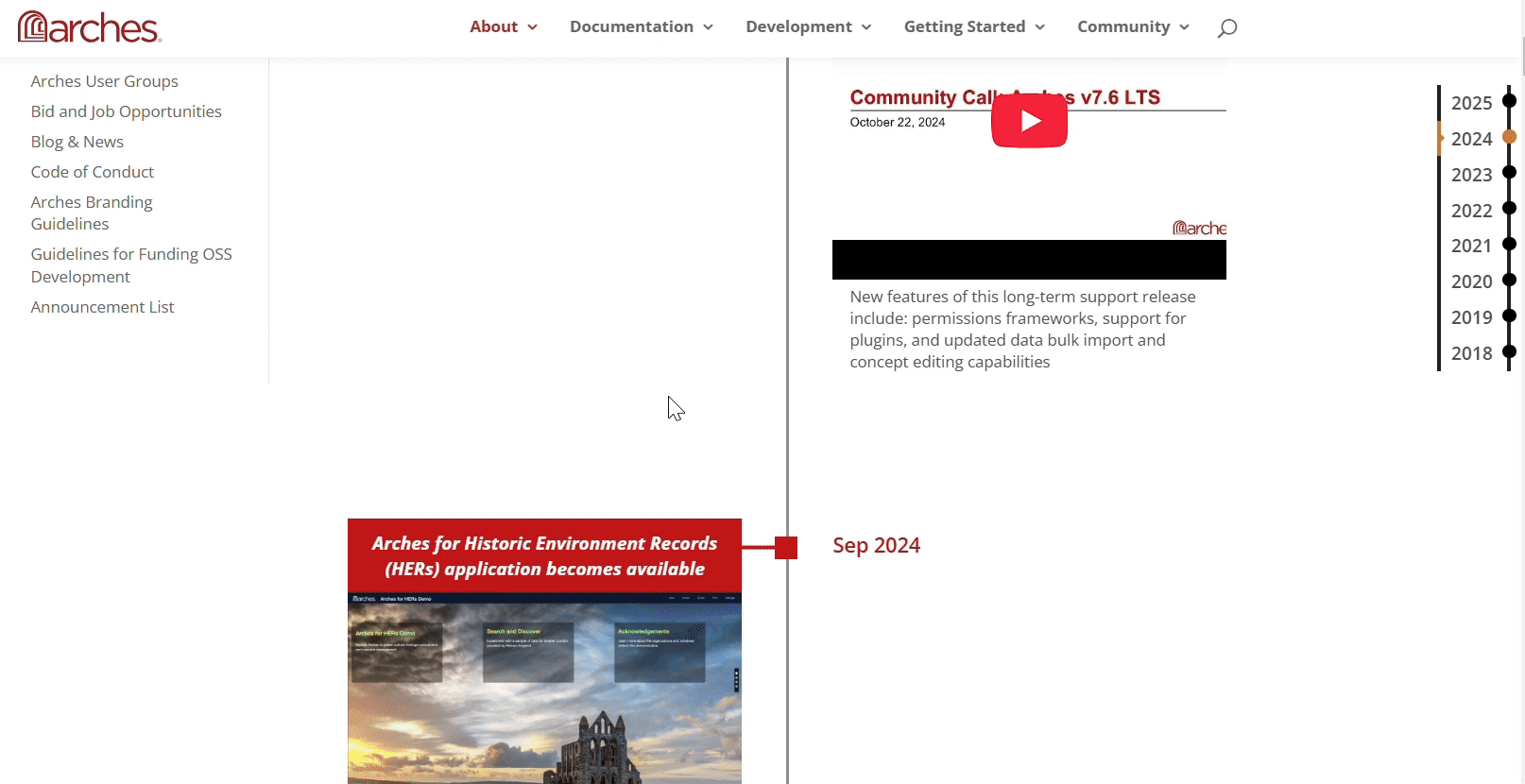The past year was once again a busy and exciting time for the Arches Project, as progress was made on several fronts, including substantial growth of its international community, new Arches deployments that included innovative uses, and significant software enhancements were released with others under development.
Collaborations & Software Releases
The launch of the Arches for HERs application in 2024, a comprehensive data management application purpose-built for UK Historic Environment Records (HERs), resulted from a long-term collaboration between the Getty Conservation Institute, Historic England (HE), and the City of Lincoln Council. We are grateful for HE’s assistance in developing the Arches for HERs demo (which has replaced the previous Arches demo).
Other collaborations with heritage organizations and knowledge management experts informed further development of Arches for Science and progress on Arches Lingo software this year. More details on these applications will be forthcoming in 2025. A significant long-term supported release of Arches core code in 2024–i.e., v7.6 LTS, introduced several features requested by the Arches community such as an enhanced bulk data editor and updated security and permissions frameworks. And projects already utilizing Arches independently developed additional components—for example, the Citation Generator workflow by the Endangered Archaeology in the Middle East and North Africa (EAMENA) project, and HE and University College London built a Climate Change Hazards for Heritage Vocabulary as part of a planned module for Arches for HERs.
New Arches Implementations
We learned of and shared many Arches implementations during 2024, including the following:
- International: Endangered Wooden Architecture Programme
- Europe & the UK: Greater London Historic Environment Record (GLHER); East Sussex Historic Environment Record (Portico); City of Antwerp Archival and Museums Collections Management Systems; Coflein: The Online Catalogue of Archaeology, Buildings, Industrial and Maritime Heritage in Wales
- Asia: Mongolian Archaeology Project: Surveying the Steppes database (MAPSSdb); Mapping Ancient and Historic Routes using Geo-Spatial Tools (MARG) database
- North America: British Columbia Register of Historic Places; British Columbia Fossil Management System
- South America: IDACORDig
Other existing Arches implementations received significant upgrades, such as Los Angeles City Planning’s Office of Historic Resources’ HistoricPlacesLA 2.0. Learn more about these new implementations on the “Who is Using Arches?” webpage.
We also highlighted a number of organizations preparing Arches deployments, such as:
- Te Kaunihera o Tāmaki Makaurau/Auckland Council’s Tūtangi Ora O Ngā Mana Kōrero platform in New Zealand
- Northern Ireland Department for Communities, Historic Environment Division (HED)
- City of West Hollywood, Current and Historic Preservation Planning Division
- California State Office of Historic Preservation
- South East Technological University (Ireland), mementoArtem
Of note, Arches software was used to exclusively manage museum and archival collections data for the first time in 2024, when the City of Antwerp deployed Arches to manage museum and archival data for four city institutions. This highlights the flexibility and extensibility of Arches for various kinds of cultural heritage data management and provides a pathway for other museums and archives to adopt Arches.
Community Highlights
Arches community members shared their research and experience with Arches software during the year through presentations, conference papers, journal articles, blogs, and videos. Explore the ‘Community Highlights’ of previous bulletins to learn more: May recap, August recap, and November recap.
In March, Farallon Geographics organized the first ever Arches in-person Developer Meeting, in Los Angeles. The event was a resounding success, drawing 30 developers representing 11 organizations from 6 countries. A follow-up virtual Developer Meeting, organized by Scholium Technologies, occurred in October, featuring 4 presentations and productive group discussions. These events sparked new opportunities for collaboration, energizing the Arches developer community and fostering deeper connections.
Community members also took advantage of existing annual conferences to reach out to new audiences. For example, in April, the Arches Project team was joined by the Auckland Council Heritage Unit to deliver two workshops at the Computer Applications and Quantitative Methods in Archaeology (CAA) conference in Auckland, NZ. In May, Arches implementers from the City and County of San Francisco and the City of Los Angeles, representatives from service providers Farallon Geographics and Scholium Technologies, and Arches Project team members participated in a joint panel presentation and discussion at the California Preservation Foundation (CPF) conference in Los Angeles.
The Arches community continued to gather throughout the year for user group meetings. Joining the existing US and UK User Groups, the Arches Modeling User Group had its initial virtual convening in July 2024 and will continue to meet online quarterly to share knowledge about creating Arches Resource Models.
Community Resources
The Arches global network continued to grow in 2024 with 12 new Arches-related job opportunities posted on the Arches website, more than 70 new members joining the Community Forum, and the addition of new service providers and expanded capacity of existing service providers as noted on the Arches Service Providers page.
In order to support the burgeoning community, many new online resources were created in 2024, including:
- A new Bluesky account
- A new demo site and tutorials
- Regularly-updated documentation on Read the Docs
- New and updated Arches Project web pages:
- Instructional videos on software releases:
Gratitude & Looking Forward
Helping the Arches Project transition to a more community-governed and sustainable open source project remains a key objective; great strides have been made in establishing Arches governance moving into 2025 and more information can be found on the Arches Project Governance and Financial Support page.
We sincerely thank all who have contributed to growing and strengthening the Arches community this year, and we’re excited to share more upcoming news in our February 2025 issue of the Arches quarterly bulletin!
